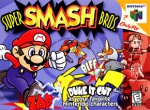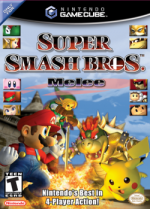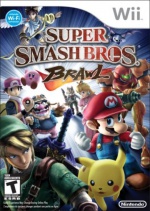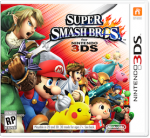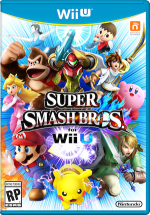Super Smash Bros. (series): Difference between revisions
Torchickens (talk | contribs) No edit summary |
Torchickens (talk | contribs) mNo edit summary |
||
| Line 24: | Line 24: | ||
|[[nwiki:Nintendo 64|Nintendo 64]] | |[[nwiki:Nintendo 64|Nintendo 64]] | ||
|{{releasedateB|Japan|January 21, 1999|USA|April 26, 1999|Europe|November 19, 1999}} | |{{releasedateB|Japan|January 21, 1999|USA|April 26, 1999|Europe|November 19, 1999}} | ||
|No relevance | |No relevance. | ||
|- | |- | ||
|''[[smashwiki:Super Smash Bros. Melee|Super Smash Bros. Melee]]'' | |''[[smashwiki:Super Smash Bros. Melee|Super Smash Bros. Melee]]'' | ||
| Line 31: | Line 31: | ||
|[[Nintendo GameCube]] | |[[Nintendo GameCube]] | ||
|{{releasedateB|Japan|November 21, 2001|USA|December 3, 2001|Europe|May 24, 2002|Australia|May 31, 2002}} | |{{releasedateB|Japan|November 21, 2001|USA|December 3, 2001|Europe|May 24, 2002|Australia|May 31, 2002}} | ||
|No relevance | |No relevance. | ||
|- | |- | ||
|''[[Super Smash Bros. Brawl]]'' | |''[[Super Smash Bros. Brawl]]'' | ||
| Line 38: | Line 38: | ||
|[[Wii]] | |[[Wii]] | ||
|{{releasedateB|Japan|January 31, 2008|USA|March 9, 2008|Australia|June 26, 2008|Europe|June 27, 2008|South Korea|April 29, 2010}} | |{{releasedateB|Japan|January 31, 2008|USA|March 9, 2008|Australia|June 26, 2008|Europe|June 27, 2008|South Korea|April 29, 2010}} | ||
|''[[Super Smash Bros. Brawl]]'' marked the appearance of [[Starfy]] ("Stafy") as an [[smashwiki:Assist Trophy|Assist Trophy]] and [[smashwiki:Trophy|Trophy]], a [[Starly]] ("Stapy") Trophy, as well as [[smashwiki:Sticker|Sticker]]s of Starfy, Starly, [[Moe]] (Kyorosuke), [[Chonmagyo]], [[Mattel]] (Materu), [[Seiuchi-kun]] and [[Herman]] (Yadokarita) | |''[[Super Smash Bros. Brawl]]'' marked the appearance of [[Starfy]] ("Stafy") as an [[smashwiki:Assist Trophy|Assist Trophy]] and [[smashwiki:Trophy|Trophy]], a [[Starly]] ("Stapy") Trophy, as well as [[smashwiki:Sticker|Sticker]]s of Starfy, Starly, [[Moe]] (Kyorosuke), [[Chonmagyo]], [[Mattel]] (Materu), [[Seiuchi-kun]] and [[Herman]] (Yadokarita). | ||
|- | |- | ||
|''[[Super Smash Bros. for Nintendo 3DS and Wii U|Super Smash Bros. for Nintendo 3DS]]'' | |''[[Super Smash Bros. for Nintendo 3DS and Wii U|Super Smash Bros. for Nintendo 3DS]]'' | ||
| Line 45: | Line 45: | ||
|[[Terminology#N|Nintendo 3DS]] | |[[Terminology#N|Nintendo 3DS]] | ||
|{{releasedateB|Japan|September 13, 2014|USA|October 3, 2014|Europe|October 3, 2014}} | |{{releasedateB|Japan|September 13, 2014|USA|October 3, 2014|Europe|October 3, 2014}} | ||
|Unknown | |Unknown. | ||
|- | |- | ||
|''[[Super Smash Bros. for Nintendo 3DS and Wii U|Super Smash Bros. for Wii U]]'' | |''[[Super Smash Bros. for Nintendo 3DS and Wii U|Super Smash Bros. for Wii U]]'' | ||
Revision as of 14:55, 13 June 2014
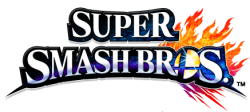
The Super Smash Bros. (Japanese: 大乱闘スマッシュブラザーズ) series, sometimes abbreviated as Sumabura (Japanese: スマブラ) in Japan, is a series of fighting games published by Nintendo. It features mainly Nintendo characters (with a few third party characters as of the third and fourth entries in the series) and the main objective of the game is to deal damage (measured in %) and knock characters off the screen. The higher % value a character has, the easier it is to knock them off the screen.
The original idea for the game originated from a prototype called "Dragon King: The Fighting Game" (Japanese: 格闘ゲーム竜王), which Satoru Iwata and Masahiro Sakurai worked on together. Masahiro Sakurai handled the planning, specs, design, modeling and movement and Satoru Iwata handled the programming. [1][2] When this game was in development, there were originally no Nintendo characters until Nintendo approved to Masahiro Sakurai's idea of adding them.
Games
|
